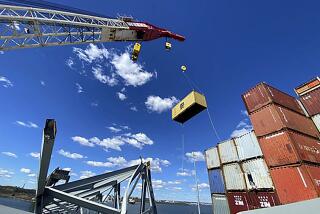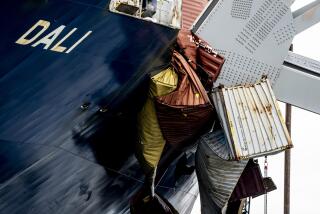Alabama reporter discovers possible wreckage of the Clotilda, the last slave ship to reach the U.S.
Daylight faded quickly as Ben Raines’ 22-foot boat, the Auriculatus, slid through the chilly waters of the Mobile-Tensaw River Delta.
Normally, Jan. 2 would be a bad day for boating. It was 25 degrees in lower Alabama, thanks to the “bomb cyclone” weather system that sent temperatures plummeting across much of the country. But the conditions were perfect for Raines, a reporter for AL.com and a local nature guide.
Water levels in the delta were more than 2 feet lower than normal, exposing the riverbanks “like peeling back a blanket over everything” — and revealing the wooden starboard of what appeared to be a 19th century ship sticking out of the mud, right where Raines expected to find it.
Experts said the wreckage may be the Clotilda, the last known ship to bring slaves to the United States.
In 1860, long after Congress made it illegal to import slaves, a crew used the ship to haul 110 men, women and children from West Africa into Alabama. Then, after the human cargo was unloaded, they secretly set it on fire.
But the story of the lost Clotilda — sometimes spelled “Clotilde” — would only grow, eventually giving scholars one of their most detailed looks into the lives of Africans who were brought to the U.S. to live in bondage.
“We know exactly who was on it. The names of all the slaves that were on it, the captives who were on it, were all recorded,” Raines said in an interview Tuesday after publishing news of his possible discovery at AL.com. “It is the only group of people brought into the country through slavery where we know exactly where they were brought in, where they were taken from in Africa, and where they ended up in the United States.”
The ban on importing slaves was supported by President Thomas Jefferson and passed by Congress in 1807. But five decades later, as the Civil War loomed, some Southerners hoped for return of the international slave trade.
Historical accounts say an Alabama plantation owner named Timothy Meaher placed a bet that he could sneak a ship full of slaves into the United States and enlisted shipwright William Foster to help him. Foster had built the Clotilda as a cargo ship, then quietly refitted it as a jail for hauling slaves.
In 1860, the Clotilda and its crew traveled to what is now Benin, loaded up the 110 passengers, and returned to Alabama in secrecy. After the captives were unloaded from the ship, Foster set the Clotilda ablaze to cover his tracks, though the ship’s remains were reportedly visible for decades afterward.
The Africans were enslaved, then freed five years later at the end of the Civil War. They formed a community called Africatown on the outskirts of Mobile that still exists today.
The story of their journey spread over the decades, eventually attracting the attention of luminaries like Booker T. Washington and Zora Neale Hurston, who interviewed the last survivor of the group of slaves, Cujdo Lewis, who would die in 1935. The community’s experience became a valuable piece of history.
“When people owned slaves, it’s not like journalists were going around interviewing slaves,” said historian Sylviane A. Diouf, who wrote a definitive account of the saga in her 2007 book, “Dreams of Africa in Alabama: The Slave Ship Clotilda and the Story of the Last Africans Brought to America.” “The fact they arrived so late, and they were free five years later — that was what enabled them to be interviewed and for other people to go and see them.”
As explorers tried and failed to find the wreckage of the Clotilda, the tale of the ship became something of a local legend.
“Everybody knows the story around here,” said 47-year-old Raines, who decided to start searching for the ship in September at the suggestion of a friend.
Raines, who is also a filmmaker whose work has appeared on Discovery Channel and National Geographic TV, has recently documented an ancient cypress forest 60 feet below water in the Gulf of Mexico, and he sometimes takes sightseers and fishermen into the river delta.
He gathered clues from Diouf’s book and from historical records, but the definitive clue came from some old-fashioned shoe-leather reporting.
“I called around to old-timers and asked if they knew where the ship was,” since it was supposedly visible in the early 1900s, Raines said. “One of them gave me a location.”
“My daddy and his friends would say, ‘That’s the Clotilda,’” he said the man told him.
Once the year’s lowest tides came in January and the winds of the “bomb cyclone” blew more of the river’s water out to sea, Raines boated out to the site with a friend — and there they found the wood of a schooner sticking out of the mud “like a dinosaur backbone.”
Raines returned with a shipwright, and, later, with John Bratten and Greg Cook, professors in the anthropology department at the University of West Florida who have studied Southern shipwreck sites.
The experts cautioned that the ship still needs to be positively identified, but they said the features of the ship match up with the style of schooners from the Clotilda’s era — and the wreckage showed signs of being set on fire.
“There was evidence that the timbers had been burned in some areas that we could see,” Cook said.
“The location is in a very good spot for this wreck,” Bratten added. “The dimensions are good.”
The researchers must now get permission from the Alabama Historical Commission and possibly other agencies to excavate the site to see what’s buried beneath the mud.
“However, such an endeavor requires both funding and planning so any question will take time to resolve,” the commission said in a statement.
Raines’ story excited one of the most famous descendants of the Clotilda’s captured passengers: Roots drummer Ahmir Thompson, best known to millions of fans as Questlove, who recently discovered his ties to the ship on PBS’ “Finding Your Roots” with Henry Gates. “My Great Great Great Grandfather was one of the 110!” Questlove tweeted at Raines.
Diouf, the scholar, was also intrigued. “For me, it would be extremely moving to actually see this wreck — if it’s that,” Diouf said. “That would be really the only slave ship that would be related to the story of people. … There were other slave ships that have been found, but we don’t necessarily know the stories.”
Raines, who was initially excited by the discovery, has grown more somber about the significance of the wreckage.
“The last time I went to the ship, I went alone, and I was just sort of sitting there next to it, and staring at it, and I had this profound feeling of ‘wow,’ what this means for so many people,” Raines said, recalling the terror the passengers must have felt being taken from their home to slavery in Alabama in the belly of the ship. “What a harrowing thing, in every way, to think about.”
To read the article in Spanish, click here
Matt Pearce is a national reporter for The Times. Follow him on Twitter at @mattdpearce.
More to Read
Start your day right
Sign up for Essential California for news, features and recommendations from the L.A. Times and beyond in your inbox six days a week.
You may occasionally receive promotional content from the Los Angeles Times.







